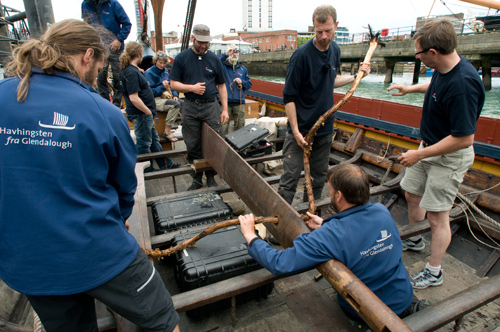Continuous maintenance is vital if chafing and minor damage are not to develop into a requirement for repairs or greater damage to the hull and rigging. Chafing of a rope can end with the rope breaking, which can in the worst case end with loss of the rigging. So it is vital to inspect the ship and make repairs en route if they cannot wait until the next port of call.
In Portsmouth, the Sea Stallion was inspected as follows:
- The floor timbers (the lowest pieces of timber that lie across the ship above the keel and support all of the bottom boards) were inspected for any breakage or damage. The wooden rivets were checked in case the wedges had worked themselves out. All OK.
- The planks were inspected for leaks. In particular we checked that none of the iron clinches in the clincherwork (where the planks overlap) had broken due to the large movements and flexibility of the hull, because that would mean the ship was no longer watertight. All OK.
- The wooden rivets and wedges in the longitudinal ceiling planks and stringers were inspected and found to be OK. One individual wedge had loosened at the leading timber head while sailing the other day.
- The mast fish looks OK. During sailing, it moves several centimetres to the sides and back and forth, partly due to the movements in the ship and also because of the mast’s pressure on the lee side of the fish. The knees that support and hold the mast fish in place have moved about 8 mm from their original position, partly due to the movements and for individual knees partly due to their drying out since they were made.
- The floor partner, which lies at decking level in the centreline, looks OK. On the basis of yet further studies of the archaeological material, we added this to the Sea Stallion after the first years’ sailing experience, when we felt that the Sea Stallion was too flexible. The floor partner stiffens the ship lengthwise.
- The keelson and the braces and locks that hold the keelson to the bottom timbers seem to be fine. All the braces fit well and there are no signs of wear or breakage.
- An old injury (from a time when the Sea Stallion came a little too quickly sideways into a mole, and the ash plank with the oar holes cracked) was originally repaired by strengthening the plank by clinching three wooden boards to the inside of the plank across the crack and between the oar holes. The damage lets a lot of water in when sailing in medium-sized waves because of the twisting of the ship. For the moment we will do nothing more, because the repair is strong enough and we must just bale out the water that comes in.
- The shrouds are fastened in a grommet that goes through the hull and around the braces supporting the thwarts. They are not fastened in the uppermost planks but in the third-highest planks level with the thwarts, which stiffens the hull across the beam. For the same reason, the thwart braces in the area of the shrouds have been strengthened using an extra wooden rivet.
- The mast seems to be fine, but has twisted a little to the left as it has dried out. This means that the hole for the halyard is now out towards the port side and this wears the halyard a little unevenly, as this comes up exactly on the centreline.
- The halyard wheel needs greasing next time the mast is lowered. When it creaks, it’s a sign that it lacks grease.
- The stay needle for the fore stay upper (the second fore stay) has caused chafing on the main fore stay. The area has been strengthened with leather. The fore stay upper has also been strengthened where it goes around the prow.
- All the shroud needles are holding and look fine.
- We shortened the tack rope by a metre because it was worn.
- We changed the rudder tackle. The “old” one was removed and looked in remarkably good condition, but the root was so damaged that it was time to change it. The rudder had worked 8 mm into the tackle, but otherwise there was no damage. A new rudder tackle was fitted after a couple of days in water but it splintered considerably more than the first. This may be because the first tackle was made in May, when there was a lot of sap in the tree, while the second was made in early April, when the sap had not yet reached the tree. Perhaps this is important not only for how easy it is to twist the tackle but also how good it is. On the other hand, the new tackle has a very fine external root. We protected this with a leather sleeve (a woggle), so that it will not wear the rudder like the old one.
